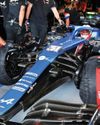
With the implementation of the FIA’s new rally class structure, comprising Rally1 through 5 groups (where Rally1 is the new naming for WRCs, Rally2 replacing R5 etc.), M-Sport was first out of the blocks with a Rally4 version of its Fiesta in early 2020.
M-Sport is unique within the WRC. Though it has a degree of manufacturer backing from Ford, it is not a ‘works’ outfit in the way Toyota and Hyundai are. Instead, under the direction of founder Malcolm Wilson, M-Sport earns its living building rally cars (alongside an increasing number of projects for other OEMs, such as Bentley GT3). With rising costs in Rally1 / WRC, it sells very few of the top-flight cars, instead relying on sales of its R5 and R2 machinery.
In essence, Rally4 is an updated set of R2 regulations and for M-Sport, the Mk8-based Rally4 Fiesta is an upgrade of its latest R2 car, homologated in 2019. The company was the first to realise the potential of running 1.0-litre, turbocharged engines in the class (as opposed to naturally aspirated 1600cc) when it released the Mk7 Fiesta R2 in 2015. Since then, it has refined the package to improve performance and keep abreast of regulatory developments.
Summing up the latest tweaks, Maciej Woda, who heads up M-Sport Poland where the R2 / Rally4 cars are built, comments: ‘The new [2019] R2 was based on the updated regulations, which allowed us to use a different turbocharger [from the OEM road car unit]. We made a lot of changes to the car, so that version was almost entirely new. There are now some small changes to the regulations with the arrival of Rally4 [compared to R2] that, for example, allow for bonnet vents to aid cooling.’
This story is from the July 2020 edition of Racecar Engineering.
Start your 7-day Magzter GOLD free trial to access thousands of curated premium stories, and 8,500+ magazines and newspapers.
Already a subscriber ? Sign In
This story is from the July 2020 edition of Racecar Engineering.
Start your 7-day Magzter GOLD free trial to access thousands of curated premium stories, and 8,500+ magazines and newspapers.
Already a subscriber? Sign In
Talk the torque
More thoughts on in-wheel motors and their effects on twisting force
Rolling about
An explanation of the limitations of a previous load transfer article, bringing jacking forces into the mix
F1 breaks schedule records
The FIA has confirmed no fewer than 23 races on the 2022 Formula 1 World Championship schedule, the highest number of grands prix ever to be held in a single season, and that has led to criticism from some teams that will be on the road for eight months.

Under pressure
Toyota may have finished first and second at Le Mans this year, but the effort required to overcome a fuel delivery problem and finish with both cars was Herculean
Physics at work
Dutch company, Intrax, offers Racecar Engineering an insight into the technologies it employs to optimise its suspension products
Williams' 2030 ambition
Williams Racing has committed to becoming climate positive by 2030 as part of an all-new sustainability strategy.
Diff'rent strokes
Racecar looks at the different types of mechanical differential, their benefits and limitations
Das Boot
A curious Twitter exchange fired up a unique, hydrogen-powered, cross-country project that will contest the Baja 1000 in November 2022

Air born
Every racecar engineer's dream is a blank sheet of paper design. When Hoonigan and Subaru approached Vermont Sportscars about building the next generation of Gymkhana racer, that's just what the company was given

Remote control
Called variously ‘virtual garages’, ‘mission control’ or ‘race support rooms’ is the future of race engineering sitting in the warm back at HQ?